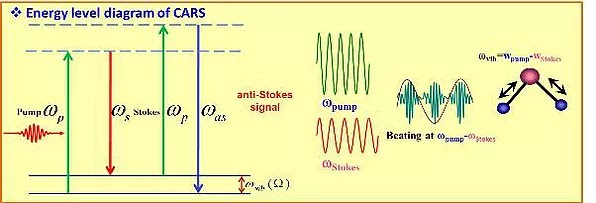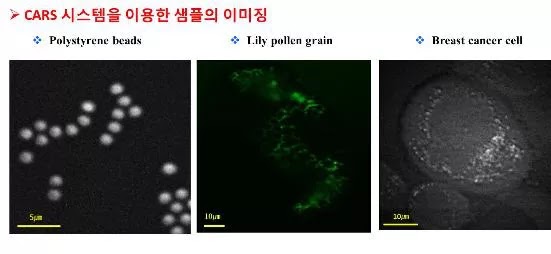펨토초 레이저는 높은 첨두 출력을 가지는 장점 덕분에 비선형 신호 발생에 용이하여 이광자 여기 형광, 2차 조화파 발생, 3차 조화파 발생, 합주파수 발생 등 다양한 비선형 현상을 이용하는 현미경에 널리 사용되고 있으며, 살아있는 세포를 연구하는데 필요한 필수 장비가 되었다. 펨토초 레이저를 이용한 '공초점 현미경'이 현재 대표적으로 사용되고 있지만 관찰을 위해 샘플에 반드시 형광물질을 투여해야 하고 이것이 세포를 죽이거나 좋지 않은 영향을 미칠 수 있다는 단점이 있다.
이를 해결하기 위한 방법으로 4광파 혼합 프로세스의 하나인 CARS 현미경이 있다. CARS는 샘플이 가지고 있는 분자의 고유한 진동 에너지 레벨에 맞춰 레이저를 입사시키게 되면 발생되는 anti-Sokes 신호를 이용하여 분자의 화학적 이미징을 할 수 있다. CARS는 샘플이 가지고 있는 분자의 고유한 진동에너지를 이용하기 때문에 어떠한 형광물질을 사용하지 않고 샘플을 관찰 할 수 있다. 특히 세포내에 어떠한 영향을 주지 않으며 공간분해능이 높고 3차원 영상이 가능하다는 장점으로 CARS 현미경은 활발히 연구되고 있다.
본 연구에서는 직접 제작한 펨토초 레이저 한대와 PCF (Photonic Crystal Fiber)를 이용하여 Multiplex CARS 시스템을 제작하였으며, 한대의 시스템으로 CARS 신호뿐만 아니라 이광자 형광 신호도 동시에 측정할 수 있는 비선형 현미경을 제작하였다. 또한 CARS와 Two-photon의 이미지를 동시에 영상화 하는데 10초 이내로 시간을 단축시키는데 성공하였다. 현재 이 시스템을 이용하여 폴리스타일렌 비드, 백합 꽃가루 및 살아있는 유방암 세포와 유방 정상 세포, 알츠하이머 뇌 조직과 정상 조직의 스펙트럼과 이미지를 측정하였으며, 추가적으로 스펙트럼 데이터를 이용해 식용유들의 진위 판별을 수행하였다.
 Raman scattering
Raman scatteringWhen light is scattered from an atom or a molecule, most photons are elastic scattering (Rayleigh scattering), such that the scattered photons have the same energy and wavelength as the incident photons have. In contrast to Rayleigh scattering, Raman scattering is inelastic scattering and has two different types depending on energy state: Stokes scattering and anti-Stokes scattering. The interaction of light with matter in a linear regime allows the absorption of the simultaneous emission of light precisely matching the difference in energy levels of the interacting electrons. Stokes scattering happens when a molecule absorbs energy, and anti-Stokes scattering happens when a molecule loses energy.
Spontaneous Raman scattering microscopy based on molecular vibrational energy is both chemically selective without staining and noninvasive, and has been extensively applied to biological molecules and the study of fine cellular structures. Confocal Raman microscopy, a variation of spontaneous Raman scattering microscopy, has been used to obtain high spatial resolution images of biological samples; however, its application is occasionally limited by a weak Raman scattering cross section, which necessitates the use of high power and a long integration time. In contrast, CARS microscopy preserves the merits of Raman microscopy while complementing for its disadvantages, as it uses pulsed lasers with high peak intensity and low average power—such as picosecond or femtosecond lasers. As such, CARS spectroscopy has been widely used for chemical and gas concentration analyses and combustion diagnostics, and is one of a four-wave mixing process that involves a pump (probe) light at a frequency of and a Stokes light at a frequency of . The CARS signal at the anti-Stokes frequency of is generated when the incident lights are tightly focused onto a sample and enhanced when exactly coincides with the Raman active band, referred to as resonance enhancement, which can be used to provide the vibrational contrast required for CARS microscopy. Note that the CARS signal intensity is proportional to the multiplication of the intensities of the incident lights, such as the pump, probe, and Stokes lights, and the third-order susceptibility. Because CARS is a coherent process, a CARS signal is generated only in a specific direction that satisfies the phase matching condition.

Our research is Multiplex CARS microscopy with spectroscopy using a femtosecond laser. Furthermore we have developed multimodal nonlinear microscopy system that combines multiplex CARS, two-photon excitation fluorescence (TPEF) microscopy and second harmonic generation (SHG) microscopy.

